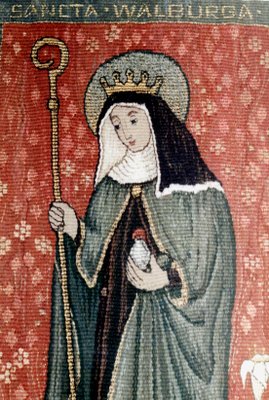Saint Walburga
 St. Walburga (d. 779) was born in England to an aristocratic family. At an early age, she was given to the care of the Benedictine nuns in Wimbourne Abbey (located in present-day Dorset) where she eventually became a nun. When her relative St. Boniface, who was a missionary monk and bishop who evangelized in Germany, asked for help from other Anglo-Saxon monasteries, St. Walburga became part of a group of nuns from Wimbourne who answered the missionary call. Later, she became abbess of the Heidenheim monastary, a double monastery of men and women founded by her brother St. Wunibald, who served as its first abbot. The legends of her life, which date from the 10th century tells stories of her gentleness, humility and charity, as well as her power to heal the sick.
St. Walburga (d. 779) was born in England to an aristocratic family. At an early age, she was given to the care of the Benedictine nuns in Wimbourne Abbey (located in present-day Dorset) where she eventually became a nun. When her relative St. Boniface, who was a missionary monk and bishop who evangelized in Germany, asked for help from other Anglo-Saxon monasteries, St. Walburga became part of a group of nuns from Wimbourne who answered the missionary call. Later, she became abbess of the Heidenheim monastary, a double monastery of men and women founded by her brother St. Wunibald, who served as its first abbot. The legends of her life, which date from the 10th century tells stories of her gentleness, humility and charity, as well as her power to heal the sick.
Many years after her death, her bones were taken from Heidenheim to the town of Eichstatt, Bavaria. An order of Benedictine nuns was founded for the purpose of maintaining her shrine. Soon after, her bones began to produce a clear liquid, called oil which people began to use as a healing tool and in prayer for the sick.
Countless believers claim to have experienced healing through her intercession. St. Walburga's oil continues to flow every year from about October 12 to February 25, two of her feast days. It seeps from her relics through a thick slab of stone where it is collected and distributed by the nuns of the Abtei St. Walburg.
The fluid is caught in a silver cup, placed beneath the slab for that purpose, and is distributed among the faithful in small vials. A chemical analysis has shown that the fluid contains nothing more than the chemical makeup of water. The first mention of the oil of St. Walburga is made as early as the ninth century by her biographer Wolfhard of Herrieden.
1 comment:
I thought you'd given up!
Post a Comment